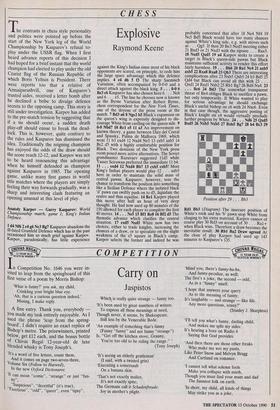CHESS
Explosive
Raymond Keene
The contrasts in chess style personality and politics were pointed up before the start of the New York leg of the World Championship by Kasparov's refusal to- play under the USSR flag. When I first heard advance reports of this decision I had hoped for a brief instant that the world champion had elected to play under the old Czarist flag of the. Russian Republic of which Boris Yeltsin is President. There were reports too that a relative of Azmaiparashvili, one of Kasparov's trusted aides, received a letter bomb after he declined a bribe to divulge defence secrets to the opposing camp. This story is still under investigation. Karpov has added to the pre-match tension by suggesting that If a tie should occur, a sudden death play-off should ensue to break the dead- lock. This is, however, quite contrary to the rules and Kasparov has dismissed the idea. Traditionally the reigning champion has enjoyed the odds of the draw should the score reach 12-12, and Karpov was not to be heard renouncing this advantage when he himself defended as champion against Kasparov in 1985. The opening game, unlike many first games in world title matches where the players are simply feeling their way forwards gradually, was a sharp and interesting clash featuring an opening unusual at this level of play.
Anatoly Karpov — Garry Kasparov: World Championship match, game 1; King's Indian Defence.
1 d4 N16 2 c4 g6 Nc3 Bg7 Kasparov abandons the ill-fated Grunfeld Defence which has in the past occasioned him so much grief against Karpov. Karpov, paradoxically, has little expenence against the King's Indian since most of his black opponents are scared, on principle, to cede him the large space advantage which this defence implies. 4 e4 d6 5 f3 The sharp Saemisch Variation, often accompanied by 0-0-0 and a direct attack against the black king. 5 . . . 0-0 6 Be3 c6 Kasparov has also chosen here 6 . . . Nc6 and 6 . . . e5. The line he chooses now is known as the Byrne Variation after Robert Byrne, chess correspondent for the New York 'Times, one of the doyens of the press room at the match. 7 Bd3 a6 8 Nge2 b5 Black's expansion on the queen's wing is expressly designed to dis- courage White from castling on the queen side. 9 0-0 Nbd7 10 Rcl e5 11 a3 An improvement on known theory, a game between Diez del Corral and Spassky, Palma de Mallorca 1969, which went 11 b3 exd4 12 Nxd4 Ne5 13 cxb5 axb5 14 Bc2 d5 with a highly comfortable position for Black. Two denizens of the New York press room posed more active alternatives. The Soviet grandmaster Razuvaev suggested 11d5 while Yasser Seirawan preferred the immediate 11 b4. 11 . . . exd4 12 Nxd4 Bbl 13 cxb5 cxb5! Most King's Indian players would play 12 . . axb5 here in order to maintain the solid mass of central pawns. Kasparov, however, sees the chance to transform the position into something like a Sicilian Defence where the isolated black 'd' pawn can swiftly push on to d5, liquidate the centre and thus equalise. 14 Rel Karpov played this move after half an hour of very deep thought. He had now used up 80 minutes of the 150 allowed for each player to complete the first 40 moves. 14 . . . Ne5 15 Bfl Re8 16 Bf2 d5 The thematic advance which clarifies the central situation. 17 exd5 NxdS White now has two choices, either to trade knights, increasing the chances of a draw, or to speculate on the slight weakness of the c5 square in Black's camp. Karpov selects the former and indeed he was probably concerned that after 18 Ne4 Nf4 19 Nc5 Bd5 Black would have too many chances against White's king side, e.g. with moves such as . . . 0g5. If then 20 Be3 Ned3 meeting either 21 Bxd3 or 21 Nxd3 with the riposte . . Rxe3. 18 NxdS QxdS 19 a4 Karpov seeks to create a target in Black's queen-side pawns but Black maintains sufficient activity to render this effort fairly harmless. 19 . . . Bh6 20 Ral Nc4 21 axb5 axb5 22 Rxa8 Rxa8 23 Qb3 There are interesting complications after 23 Nxb5 Qxb5 24 b3 Bd5 25 Qd4 but Black can avoid all this with 23 . . . Qxdl 24 Rxdl Nxb2 25 Rbl Bg7 26 Bd4 Na4. 23 . . . Bch 24 Bd3 The somewhat transparent threat of Be4 obliges Black to sacrifice a pawn, but only temporarily. If White wanted to play for serious advantage he should exchange Black's useful bishop on c6 with 24 Nxc6. Even in that case though, the aggressive posting of Black's knight on c4 would virtually preclude further progress by White. 24 . . . Nd6 25 Qxd5 BxdS 26 Nxb5 Nxb5 27 BxbS Bg7 28 b4 Bc3 29 Rdl Bb3 (Diagram) The insecure position of White's rook and his 'b' pawn stop White from clinging to his extra material. Karpov cannot of course play 30 Rd3 on account of 30 . . . Ral+ when Black wins. Therefore a draw becomes the inevitable result. 30 Rbl Bat Draw agreed At the close of play Karpov had used up 143 minutes to Kasparov's 135. Position after 29 . . . Bb3


























































 Previous page
Previous page